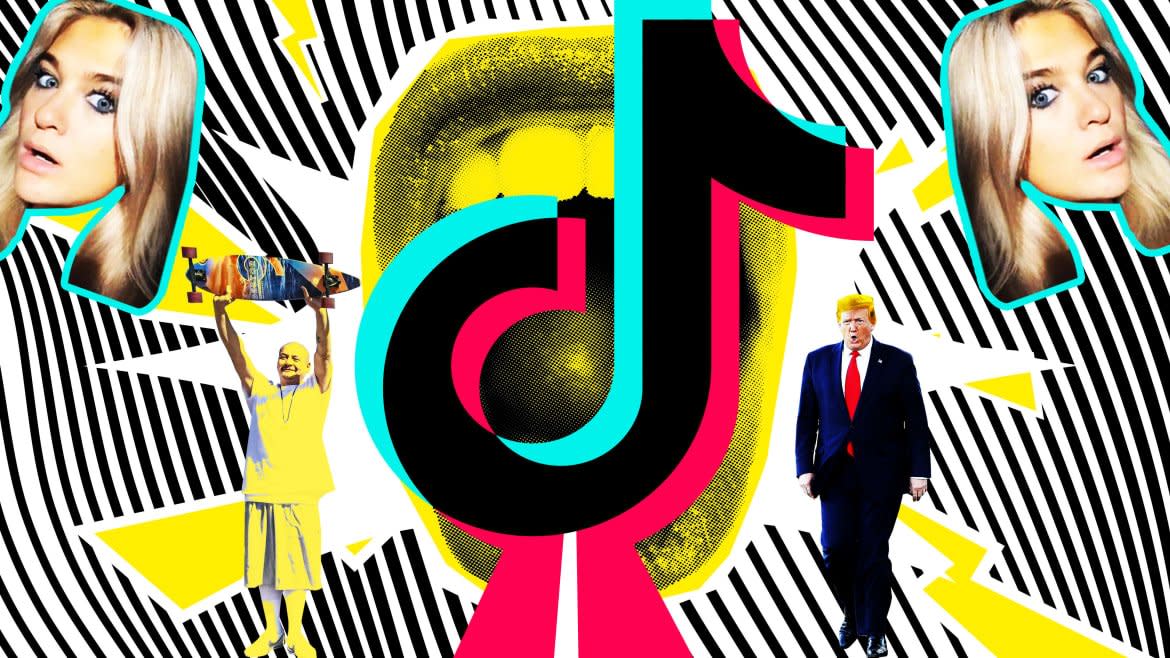The Year TikTok Took Over the World—and Drove Trump Mad

In mid-June, a 51-year-old Iowan named Mary Jo Laupp, who’d once worked on the Pete Buttigieg campaign, posted a TikTok video calling on her followers to register for an upcoming Trump rally, artificially fill the guestlist, and force the president to address an empty auditorium in Oklahoma. It seemed to work. Teens booked seats en masse under fake names like “Hugh Jass.” The auditorium held just 19,000 people, but by June 15, Trump’s campaign manager boasted of a guest list totaling more than one million. “Going to be epic!” he tweeted. On the big day though, just 6,200 people turned out. As live cameras rolled, the campaign quickly scrapped rows of extra seating and scaffolding set up outside.
After the stunt unfolded in real time, TikTok users took a victory lap; “TikTok Teens and K-Pop Stans Say They Sank Trump Rally,” a New York Times headline read. It crystallized a narrative about the younger generation as somehow novel and more cunning: clear-eyed activists, disillusioned with the status quo, and driven toward justice. “The TikTok teens will save us”—first a meme, then an outlook—absorbed everything from the youth-led climate group Sunrise Movement to Kellyanne Conway’s news-breaking 15-year-old kid, Claudia. It collapsed just as quickly. “Gen-Z Will Not Save Us,” a Times op-ed announced the same month. TikTok proved as difficult to generalize as other platforms. The user base spans the political spectrum, segmented into populations as likely to condemn cops as to be one. Where some saw idealistic divergence, skeptics argued that TikTok reflected the same spread of views you’d find anywhere else online.
Jake Paul Believes COVID Is ‘a Hoax’ and ‘98% of News Is Fake’
That could be the slogan of TikTok’s year. If every generation has its boogeyman, a newfangled teen obsession that incites pearl-clutching—comic books, Elvis, the boob tube, video games, the internet—2020 gave TikTok its turn. In August, after months of demonizing the app’s Chinese parent company, ByteDance, Trump tried to ban it. His clunkily titled “Executive Order on Addressing the Threat Posed by TikTok” warned that the app “automatically captures vast swaths of information from its users”—a potential threat from China that national security experts across the aisle took seriously. “ByteDance’s continued ownership of TikTok is unacceptable,” tech analyst Ben Thompson concluded in his influential newsletter, Stratechery.
Others saw TikTok’s surveillance as a more familiar monster, no different from the predatory data collection practices of Facebook or Google. “Being skeptical of TikTok is not weird,” Brian Feldman wrote in his newsletter, BNet. “Being skeptical of TikTok to a far larger degree than any other Big Tech company is absolutely weird.” The collapse of the ban was still more typical: after the company sold a 12.5 percent stake to Oracle, the Trump administration’s threats ceased. The deadline for the sale elapsed two weeks ago; a panel of judges cast doubts on the ban last Monday. So far, little has changed.
That’s not to say there’s nothing new about the explosion of TikTok during the pandemic. The algorithm, which curates every user’s experience of the platform, is notorious—at once more personalized and more random. “Through the process of trial and error,” critic Kyle Chayka wrote of the app’s interface, “you get an assortment of videos that are on their own niche but put together resemble something like individual taste.” It has unearthed old bands and made Average Joes celebrities overnight. When Nathan Apodaca’s car broke down on his way to work at an Idaho potato factory in September, he shot a TikTok from his skateboard drinking a bottle of Ocean Spray cranberry juice and listening to Fleetwood Mac’s “Dreams.” Overnight, he became a minor celebrity, Ocean Spray sales surged, and “Dreams” entered the Billboard Top 10 for the first time since 1977.
But even within the newness there’s a semblance of the old. The ironic TikTok cult has Instagram and Facebook predecessors. Content houses—arguably one of the weirder and more distinct developments of the app’s rise—date back to the early years of YouTube. The viral dance challenge has equally old origins. And whatever spontaneity emerges from the form is often assimilated into something more familiar. In an article on TikTok, for example, New York Times writer Susan Dominus upheld Apodaca as the embodiment of a feel-good trend on the platform. “The vibe is chill; it chills, contagiously,” she wrote. “The vibe is pure.” Maybe. But within days, the vibe had become sponcon—Ocean Spray went so far as to give Apodaca his own branded truck. “The video went so viral,” the article read elsewhere, “that TikTok co-opted it for an advertising campaign that began running during the N.B.A. finals.” The novelty is searing.
In a sense, it is the perfect app for the past year, a year we have been told again and again is different, the worst in recent memory, plagued by the most disruptive president, the most divided population, the most important election in a lifetime. It’s been framed as a kind of error or fluke, unique from years before it and ideally, from those to come. But as December comes to a close, the tally of 2020 looks a lot like those before it: a grid-locked Congress, a paltry stimulus package, an ever-wealthier Jeff Bezos, an expanding poverty class, a deteriorating climate, a cratering health-care system, and a new administration filled with alums from eight years ago. To that end, TikTok and 2020 share a crucial characteristic: neither quite breaks from the past, they just gave us more of it.
Got a tip? Send it to The Daily Beast here
Get our top stories in your inbox every day. Sign up now!
Daily Beast Membership: Beast Inside goes deeper on the stories that matter to you. Learn more.

